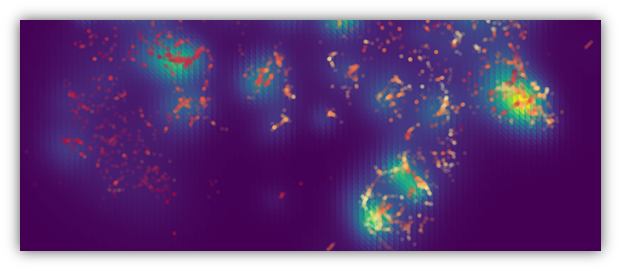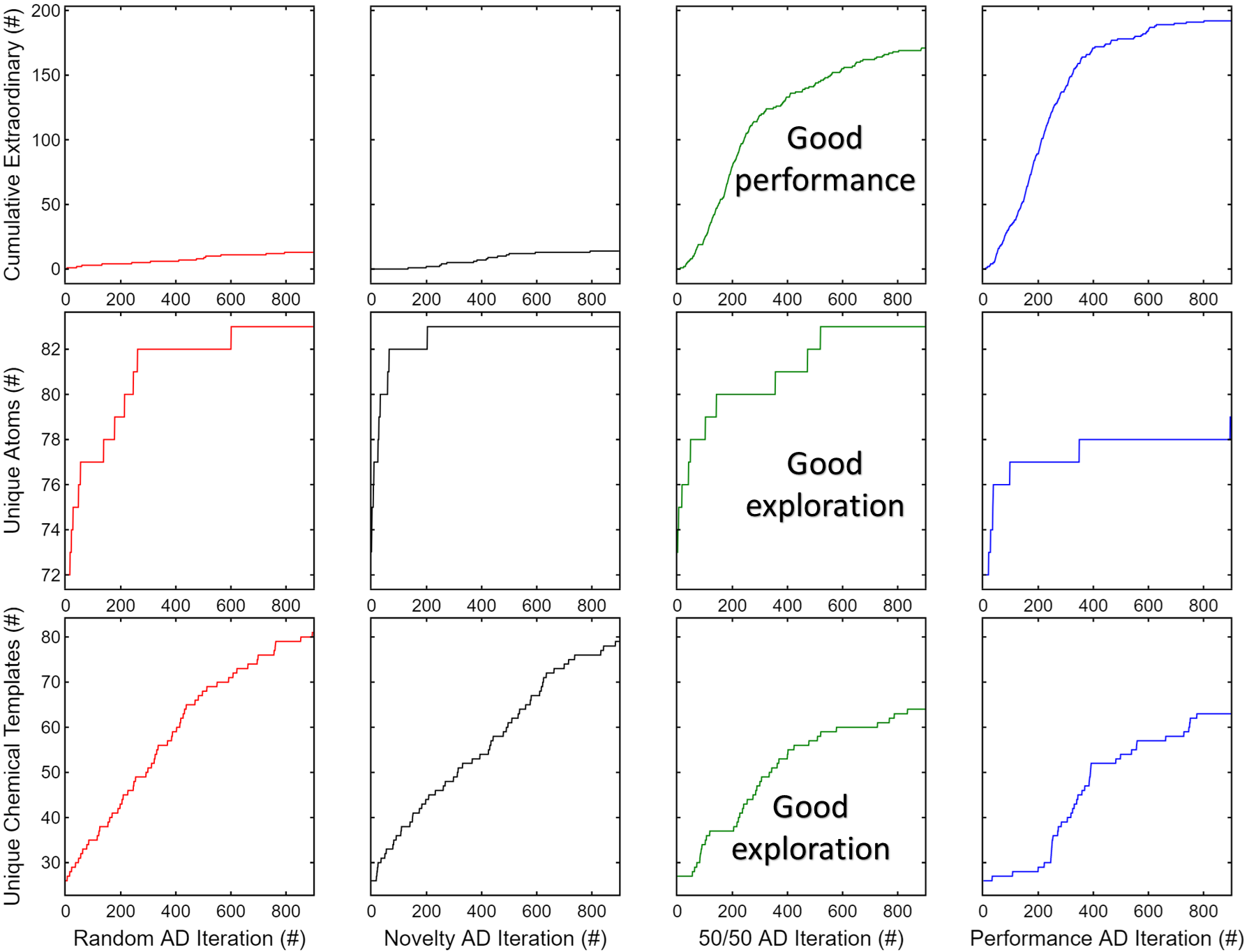Data-driven materials discovery based on composition.
Project description
DiSCoVeR
A materials discovery algorithm geared towards exploring high performance candidates in new chemical spaces using composition-only.

Bulk modulus values overlaid on DensMAP densities (cropped).
We describe the DiSCoVeR algorithm, how to install mat_discover, basic usage (e.g.
fit/predict, custom or built-in datasets, adaptive design). Interactive plots for several types of
Pareto front plots are available via the mat_discover documentation. We also describe how
to contribute, what to do if you run into bugs or have questions, and citation information.
The article (ChemRxiv) is under review at Digital Discovery (2021-12-10). See Citing.
DiSCoVeR Workflow
Why you'd want to use this tool, whether it's "any good", alternative tools, and summaries of the workflow.
Why DiSCoVeR?
The primary anticipated use-case of DiSCoVeR is that you have some training data (chemical formulas and target property), and you would like to determine the "next best experiment" to perform based on a user-defined relative importance of performance vs. chemical novelty. You can even run the model without any training targets which is equivalent to setting the target weight as 0.
Is it any good?
Take an initial training set of 100 chemical formulas and associated Materials Project bulk moduli followed by 900 adaptive design iterations (x-axis) using random search, novelty-only (performance weighted at 0), a 50/50 weighting split, and performance-only (novelty weighted at 0). These are the columns. The rows are the total number of observed "extraordinary" compounds (top 2%), the total number of additional unique atoms, and total number of additional unique chemical formulae templates. These are the rows. In other words:
- How many "extraordinary" compounds have been observed so far?
- How many unique atoms have been explored so far? (not counting atoms already in the starting 100 formulas)
- How many unique chemical templates (e.g. A2B3, ABC, ABC2) have been explored so far? (not counting templates already in the starting 100 formulas)
The 50/50 weighting split offers a good trade-off between performance and novelty. Click the image to navigate to the interactive figure.

Alternatives
This approach is similar to what you will find with Bayesian optimization (BO), but with explicit emphasis on chemical novelty. If you're interested in doing Bayesian optimization, I recommend using Facebook/Ax (not affiliated). I am working on an implementation of composition-based Bayesian optimization using Ax (2021-12-10).
For alternative "suggest next experiment" materials discovery algorithms, see CAMD (trihackathon2020 tutorial notebooks), PyChemia, Heteroscedastic-BO, and thermo.
For materials informatics (MI) and other relevant codebases/links, see:
- my lists of (total ~200) MI codebases,
in particular:
- materials discovery
- composition-, crystal structure-, and molecule-based predictions
- MI databases, especially NOMAD
- MI materials synthesis
- MI natural language processing
- physics-based MI simulations
- Other lists of MI-relevant codebases:
- this curated list of "Awesome" materials informatics (~100 as of 2021-12-10)
Visualization
The DiSCoVeR workflow is visualized as follows:

Figure 1: DiSCoVeR workflow to create chemically homogeneous clusters. (a) Training and validation data are obtained inthe form of chemical formulas and target properties (i.e. performance). (b) The training and validation chemical formulasare combined and used to compute ElMD pairwise distances. (c) ElMD pairwise distance matrices are used to computeDensMAP embeddings and DensMAP densities. (d) DensMAP embeddings are used to compute HDBSCAN* clusters.(e) Validation target property predictions are made via CrabNet and plotted against the uniqueness proxy (e.g. densityproxy) in the form of a Pareto front plot. Discovery scores are assigned based on the (arbitrarily) weighted sum of scaledperformance and uniqueness proxy. Higher scores are better. (f) HDBSCAN* clustering results can be used to obtain acluster-wise performance (e.g. average target property) plotted against a cluster-wise uniqueness proxy (e.g. fraction ofvalidation compounds vs. total compounds within a cluster).
Tabular Summary
A summary of the DiSCoVeR methods are given in the following table:
Table 1: A description of methods used in this work and each method’s role in DiSCoVeR.∗A Pareto front is moreinformation-dense than a proxy score in that there are no predefined relative weights for performance vs. uniquenessproxy. Compounds that are closer to the Pareto front are better. The upper areas of the plot represent a higher weighttowards performance while the right-most areas of the plot represent a higher weight towards uniqueness.
| Method | What is it? | What is its role in DiSCoVeR? |
|---|---|---|
| CrabNet | Composition-based property regression | Predict performance for proxy scores |
| ElMD | Composition-based distance metric | Supply distance matrix to DensMAP |
| DensMAP | Density-aware dimensionality reduction | Obtain densities for density proxy |
| HDBSCAN* | Density-aware clustering | Create chemically homogeneous clusters |
| Peak proxy | High performance relative to nearby compounds | Proxy for "surprising" high performance |
| Density proxy | Sparsity relative to nearby compounds | Proxy for chemical novelty |
| Peak proxy score | Weighted sum of performance and peak proxy | Used to rank compounds |
| Density proxy score | Weighted sum of performance and density proxy | Used to rank compounds |
| Pareto front | Optimal performance/uniqueness trade-offs | Visually screen compounds (no weights*) |
Installation
I recommend that you run mat_discover in a separate conda environment, at least for
initial testing. After installing
Anaconda or
Miniconda, you can create a new
environment
in Python 3.8 (for which mat_discover is tested) via:
conda create --name mat_discover python==3.8
There are three ways to install mat_discover: Anaconda (conda), PyPI (pip), and from source. Anaconda is the preferred method.
Anaconda
To install mat_discover using conda, first, update conda via:
conda update conda
The Anaconda mat_discover package is hosted on the @sgbaird channel and can be installed via:
conda install -c sgbaird mat_discover
Pip
To install via pip, first update pip via:
pip install -U pip
Due to limitations of PyPI distributions of CUDA/PyTorch, you will need to install PyTorch separately via the command that's most relevant to you (PyTorch Getting Started). For example, for Stable/Windows/Pip/Python/CUDA-11.3:
pip3 install torch==1.10.0+cu113 -f https://download.pytorch.org/whl/cu113/torch_stable.html
Finally, install mat_discover:
pip install mat_discover
From Source
To install from source, clone the mat_discover repository:
git clone https://github.com/sparks-baird/mat_discover.git
cd mat_discover
To perform the local installation, you can use pip, conda, or flit. If using flit, make sure to install it first via conda install flit or pip install flit.
| pip | conda | flit |
|---|---|---|
pip install -e . |
conda env create --file environment.yml |
flit install --pth-file |
Basic Usage
How to fit/predict, use custom or built-in datasets, and perform adaptive design.
Fit/Predict
from mat_discover.mat_discover_ import Discover
disc = Discover()
disc.fit(train_df) # DataFrames should have at minimum "formula" and "target" columns
scores = disc.predict(val_df)
disc.plot()
disc.save()
print(disc.dens_score_df.head(10), disc.peak_score_df.head(10))
⚠️ ignore the "validation" mean absolute error (MAE) command line output during
disc.fit(train_df)⚠️
See
mat_discover_example.py,


Load Data
If you're using your own dataset, you will need to supply a Pandas DataFrame that
contains formula (string) and target (numeric) columns. If you have a train.csv file
(located in current working directory) with these two columns, this can be converted to
a DataFrame via:
import pandas as pd
train_df = pd.read_csv("train.csv")
For validation data without known property values to be used with predict, dummy
values (all zeros) are assigned internally. In this case, you can read in a CSV file
that contains only the formula (string) column:
val_df = pd.read_csv("val.csv")
Note that you can load any of the datasets within CrabNet/data/, which includes matbench data, other datasets from the CrabNet paper, and a recent (as of Oct 2021) snapshot of K_VRH bulk modulus data from Materials Project. For example, to load the bulk modulus snapshot:
from crabnet.data.materials_data import elasticity
train_df, val_df = disc.data(elasticity, "train.csv") # note that `val.csv` within `elasticity` is every other Materials Project compound (i.e. "target" column filled with zeros)
The built-in data directories are as follows:
{'benchmark_data', 'benchmark_data.CritExam__Ed', 'benchmark_data.CritExam__Ef', 'benchmark_data.OQMD_Bandgap', 'benchmark_data.OQMD_Energy_per_atom', 'benchmark_data.OQMD_Formation_Enthalpy', 'benchmark_data.OQMD_Volume_per_atom', 'benchmark_data.aflow__Egap', 'benchmark_data.aflow__ael_bulk_modulus_vrh', 'benchmark_data.aflow__ael_debye_temperature', 'benchmark_data.aflow__ael_shear_modulus_vrh', 'benchmark_data.aflow__agl_thermal_conductivity_300K', 'benchmark_data.aflow__agl_thermal_expansion_300K', 'benchmark_data.aflow__energy_atom', 'benchmark_data.mp_bulk_modulus', 'benchmark_data.mp_e_hull', 'benchmark_data.mp_elastic_anisotropy', 'benchmark_data.mp_mu_b', 'benchmark_data.mp_shear_modulus', 'element_properties', 'matbench', 'materials_data', 'materials_data.elasticity', 'materials_data.example_materials_property'}
To see what .csv files are available (e.g. train.csv), you will probably need to navigate to CrabNet/data/ and explore.
Finally, to download data from Materials Project directly, see generate_elasticity_data.py.
Adaptive Design
The anticipated end-use of mat_discover is in an adaptive design scheme where the objective function (e.g. wetlab synthesis and characterization) is expensive. After loading some data for a validation scenario (or your own data)
from crabnet.data.materials_data import elasticity
from mat_discover.utils.data import data
from mat_discover.adaptive_design import Adapt
train_df, val_df = data(elasticity, "train.csv", dummy=False, random_state=42)
train_df, val_df, extraordinary_thresh = extraordinary_split(
train_df, val_df, train_size=100, extraordinary_percentile=0.98, random_state=42
)
you can then predict your first additional experiment to run via:
adapt = Adapt(train_df, val_df, timed=False)
first_experiment = adapt.suggest_first_experiment() # fit Discover() to train_df, then move top-ranked from val_df to train_df
Subsequent experiments are suggested as follows:
second_experiment = adapt.suggest_next_experiment() # refit CrabNet, use existing DensMAP data, move top-ranked from val to train
third_experiment = adapt.suggest_next_experiment()
Alternatively, you can do this in a closed loop via:
n_iter = 100
adapt.closed_loop_adaptive_design(n_experiments=n_iter, print_experiment=False)
However, as the name suggests, the closed loop approach does not allow you to input data after each suggested experiment.
Developing and Contributing
This project was developed primarily in Python in Visual Studio Code using black, mypy, pydocstyle, kite, other tools, and various community extensions. Some other notable tools used in this project are:
- Miniconda
pipreqswas used as a starting point forrequirements.txtflitis used to createpyproject.tomlto publish to PyPIconda env export --from-history -f environment.ymlwas used as a starting point forenvironment.ymlgrayskullandconda-souschefare used to generate and tweakmeta.yaml, respectively, for publishing to Anaconda (if you know how to get this up on conda-forge, help is welcome 😉)- A variety of GitHub actions are used (see workflows)
pytestis used for testingnumbais used to accelerate the Wasserstein distance matrix computations via CPU or GPU
For simple changes, navigate to github.com/sparks-baird/mat_discover, click on the
relevant file (e.g. README.md), and look for the pencil (✏️). GitHub will walk you
through the rest.
To help with in-depth development, you will need to install from
source. Note that when using a conda environment
(recommended), you may avoid certain issues down the road by opening VS Code via an
Anaconda command prompt and entering the command code (at least until the VS Code devs
fix some of the issues associated with opening it "normally"). For example, in Windows,
press the "Windows" key, type "anaconda", and open "Anaconda Powershell Prompt
(miniconda3)" or similar. Then type code and press enter. To build the docs, first install sphinx and sphinx_rtd_theme. Then run:
cd docs/
make html
And open docs/build/index.html (e.g. via start index.html on Windows)
Bugs, Questions, and Suggestions
If you find a bug or have suggestions for documentation please open an
issue. If you're
reporting a bug, please include a simplified reproducer. If you have questions, have
feature suggestions/requests, or are interested in extending/improving mat_discover
and would like to discuss, please use the Discussions tab and use the appropriate
category ("Ideas", "Q&A", etc.). If you have a
question, please ask! I won't bite. Pull requests are welcome and encouraged.
Citing
The preprint is hosted on ChemRxiv:
Baird S, Diep T, Sparks T. DiSCoVeR: a Materials Discovery Screening Tool for High Performance, Unique Chemical Compositions. ChemRxiv 2021. doi:10.33774/chemrxiv-2021-5l2f8-v3. This content is a preprint and has not been peer-reviewed.
The BibTeX citation is as follows:
@article{baird_diep_sparks_2021,
place={Cambridge},
title={DiSCoVeR: a Materials Discovery Screening Tool for High Performance, Unique Chemical Compositions},
DOI={10.33774/chemrxiv-2021-5l2f8-v3},
journal={ChemRxiv},
publisher={Cambridge Open Engage},
author={Baird, Sterling and Diep, Tran and Sparks, Taylor},
year={2021}
}
The article is under review at Digital Discovery.
Project details
Release history Release notifications | RSS feed
Download files
Download the file for your platform. If you're not sure which to choose, learn more about installing packages.
Source Distribution
Built Distribution
Hashes for mat_discover-2.0.0-py2.py3-none-any.whl
| Algorithm | Hash digest | |
|---|---|---|
| SHA256 | 78ab1dc6084e7dcb2d493350778a552702be606cc1f6c0134cf1c37091c15d54 |
|
| MD5 | 2a68514091aaad95b8553748e12f3062 |
|
| BLAKE2b-256 | f43b97171a274b6247a3f3f029ac2372a3e12596c690ad0433398464c0e44594 |
























